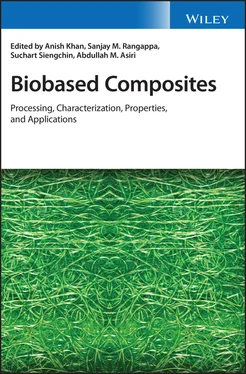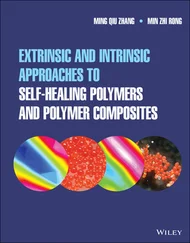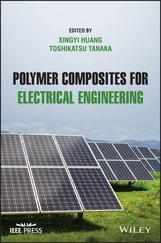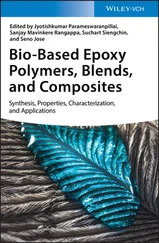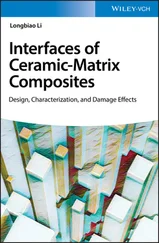Biobased Composites
Здесь есть возможность читать онлайн «Biobased Composites» — ознакомительный отрывок электронной книги совершенно бесплатно, а после прочтения отрывка купить полную версию. В некоторых случаях можно слушать аудио, скачать через торрент в формате fb2 и присутствует краткое содержание. Жанр: unrecognised, на английском языке. Описание произведения, (предисловие) а так же отзывы посетителей доступны на портале библиотеки ЛибКат.
- Название:Biobased Composites
- Автор:
- Жанр:
- Год:неизвестен
- ISBN:нет данных
- Рейтинг книги:4 / 5. Голосов: 1
-
Избранное:Добавить в избранное
- Отзывы:
-
Ваша оценка:
- 80
- 1
- 2
- 3
- 4
- 5
Biobased Composites: краткое содержание, описание и аннотация
Предлагаем к чтению аннотацию, описание, краткое содержание или предисловие (зависит от того, что написал сам автор книги «Biobased Composites»). Если вы не нашли необходимую информацию о книге — напишите в комментариях, мы постараемся отыскать её.
Biobased Composites: Processing, Characterization, Properties, and Applications
Biobased Composites
Biobased Composites — читать онлайн ознакомительный отрывок
Ниже представлен текст книги, разбитый по страницам. Система сохранения места последней прочитанной страницы, позволяет с удобством читать онлайн бесплатно книгу «Biobased Composites», без необходимости каждый раз заново искать на чём Вы остановились. Поставьте закладку, и сможете в любой момент перейти на страницу, на которой закончили чтение.
Интервал:
Закладка:
A. V. KiruthikaAssistant Professor of Physics, Seethalakshmi Achi College for Women, Pallathur, Tamil Nadu, India
Dipen Kumar RajakDepartment of Mechanical Engineering, Sandip Institute of Technology and Research Centre, Nashik, Maharashtra, India
Pawan Kumar RakeshDepartment of Mechanical Engineering, NIT, Srinagar, Uttarakhand, India
J. ManirajDepartment of Mechanical Engineering, KIT‐Kalaignarkarunanidhi Institute of Technology, Coimbatore, Tamil Nadu, India
Moises MeloDepartment of Textile Engineering, Laboratory of Characterization of the Textile Materials, Federal University of Rio Grande do Norte, Natal, RN, Brazil
H. MohitDepartment of Mechanical Engineering, National Institute of Technology, Tiruchirappalli, India
K. MonroeChemistry and Biochemistry Department, Georgia Southern University, Statesboro, GA, USA
Kátia MoreiraDepartment of Textile Engineering, Textile Engineering Laboratory, Federal University of Rio Grande do Norte, Natal, RN, Brazil
Durgesh D. PagarDepartment of Mechanical Engineering, K. K. Wagh Institute of Engineering Education and Research, Nashik, Maharashtra, India
Catalin I. PruncuDepartment of Mechanical Engineering, Imperial College London, London, UK Department of Mechanical Engineering, School of Engineering, University of Birmingham, Birmingham, UK
R. L. QuirinoChemistry and Biochemistry Department, Georgia Southern University, Statesboro, GA, USA
N. Rajesh Jesudoss HynesDepartment of Mechanical Engineering, Mepco Schlenk Engineering College, Sivakasi, Tamil Nadu, India
L. Rajesh KumarDepartment of Mechanical Engineering, KPR Institute of Engineering and Technology, Coimbatore, Tamil Nadu, India
N. RajiniDepartment of Mechanical Engineering, Kalasalingam Academy of Research and Education, Krishnankoil, Tamil Nadu, India
M. RameshDepartment of Mechanical Engineering, KIT‐Kalaignarkarunanidhi Institute of Technology, Coimbatore, Tamil Nadu, India
P. RameshDepartment of Production Engineering, National Institute of Technology, Tiruchirappalli, India
T. RameshDepartment of Mechanical Engineering, National Institute of Technology, Tiruchirappalli, Tamil Nadu, India
Lalit RanakotiDepartment of Mechanical Engineering, NIT, Srinagar, Uttarakhand, India
M. R. SanjayNatural Composites Research Group Lab, Academic Enhancement Department, King Mongkut's University of Technology North Bangkok, Bangkok, Thailand
Thiago SantosDepartment of Textile Engineering, Textile Engineering Laboratory, Federal University of Rio Grande do Norte, Natal, RN, Brazil
Caroliny SantosDepartment of Textile Engineering, Textile Engineering Laboratory, Federal University of Rio Grande do Norte, Natal, RN, Brazil
K. SenthilkumarDepartment of Mechanical Engineering, Kalasalingam Academy of Research and Education, Krishnankoil, Tamil Nadu, India Department of Mechanical and Process Engineering, The Sirindhorn International Thai German Graduate School of Engineering (TGGS), King Mongkut's University of Technology North Bangkok, Bangkok, Thailand
T. Senthil Muthu KumarDepartment of Mechanical Engineering, Kalasalingam Academy of Research and Education, Krishnankoil, Tamil Nadu, India Department of Mechanical and Process Engineering, The Sirindhorn International Thai German Graduate School of Engineering (TGGS), King Mongkut's University of Technology North Bangkok, Bangkok, Thailand
P. Shenbaga VeluDepartment of Mechanical Engineering, P.S.R Engineering College, Sivakasi, Tamil Nadu, India
Suchart SiengchinDepartment of Materials and Production Engineering, The Sirindhorn International Thai German Graduate School of Engineering (TGGS), King Mongkut's University of Technology North Bangkok, Bangkok, Thailand Natural Composites Research Group Lab, King Mongkut's University of Technology North Bangkok, Bangkok, Thailand
Anna SienkiewiczDepartment of Chemistry and Technology of Polymers, Cracow University of Technology, Cracow, Poland
N. J. VigneshDepartment of Mechanical Engineering, Mepco Schlenk Engineering College, Sivakasi, Tamil Nadu, India
Madhu YadavDepartment of Chemistry, Bioorganic Research Laboratory, University of Allahabad, Allahabad, Uttar Pradesh, India GGIC, Prayagraj, Uttar Pradesh, India
Preface
The objective of this book is to summarize many of the recent developments in the area of biobased composites. As the title indicates, this book emphasizes new challenges for the characterization, properties, and applications of biobased composites. This book provides an update of all the important areas of (processing, characterisation, properties and application) biobased composites in a comprehensive manner. This book covers the void for the need of one‐stop reference book for the researchers. Leading researchers from industry, academy, government, and private research institutions across the globe have contributed the chapters for the book. Academics, researchers, scientists, engineers, and students in the field of biobased composites will benefit from this book, which is highly application oriented.
The editors are thankful to all the authors for their contribution. The editors also thank the editorial and publishing team for their guidance and support.
1 Introduction to Biobased Composites
Faris M. AL‐Oqla
Department of Mechanical Engineering, The Hashemite University, Zarqa 13133, Jordan
1.1 Introduction
Tons of industrial wastes are dumped daily in every region of the world, making the recycling of these wastes a very critical environmental concern. For environmental‐friendly industries, materials from renewable resources should be used to replace conventional materials. Hence, the sustainability will be ensured, and cheaper as well as ecological alternative products will compete with the current products from nonrenewable resources [1–3].
Biobased composite materials and green products are increasingly substituting the traditional materials and products in a wide range of applications for sustainable industries, though massive efforts are still essential to better exploit such biomaterials as well as to expand their applications [4–6]. Moreover, the necessity to advance their potentials for consistent and reliable performance is still demanding [7]. To achieve these goals, founding a well‐organized and robust evaluation and selection system for the composite constituents is the most important step [8, 9]. In such techniques, several preferred fibers as well as polymer assets including mechanical, physical, economic, and environmental, have to be revealed in parallel and assessed to determine the best type of fibers for a certain application [9–11]. Further, proper capabilities and performance of new materials including the biobased ones, would enhance their industrial applications.
The weather, on the other hand, is also reaching more extremes in both hot and cold conditions and negatively affecting the available resources and the environment. Ice formation is sharply decaying over the past years due to climate changes. It is believed that the fast‐increasing manner of temperature over years due to global warming leads to shorter winters, breaking the natural balance in climate resulting in the destruction of available resources. The rising of sea level due to melting of ice is also a serious problem that can lead to catastrophic disasters on the sea‐neighbor lands, which would negatively affect the environment. Natural fibers are considered renewable resources and can be recycled from many industrial process wastes. These natural fibers are obtained from plant sources, such as hemp, or from animal sources [12, 13]. Natural fibers of plant sources comprise cellulose, hemicellulose, and lignin; natural fibers of animal sources consist of mainly proteins. Natural fibers can be utilized in various sizes from macro‐ to nanoscale fibers. For instance, the nanocellulose fibers can be utilized in a wide range of applications as indicated in Figure 1.1.
Читать дальшеИнтервал:
Закладка:
Похожие книги на «Biobased Composites»
Представляем Вашему вниманию похожие книги на «Biobased Composites» списком для выбора. Мы отобрали схожую по названию и смыслу литературу в надежде предоставить читателям больше вариантов отыскать новые, интересные, ещё непрочитанные произведения.
Обсуждение, отзывы о книге «Biobased Composites» и просто собственные мнения читателей. Оставьте ваши комментарии, напишите, что Вы думаете о произведении, его смысле или главных героях. Укажите что конкретно понравилось, а что нет, и почему Вы так считаете.
